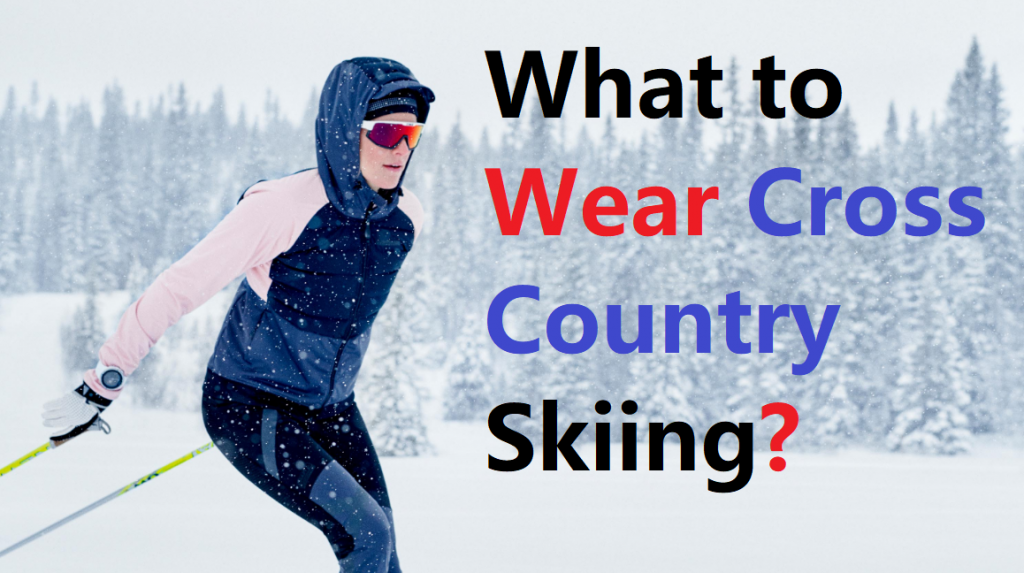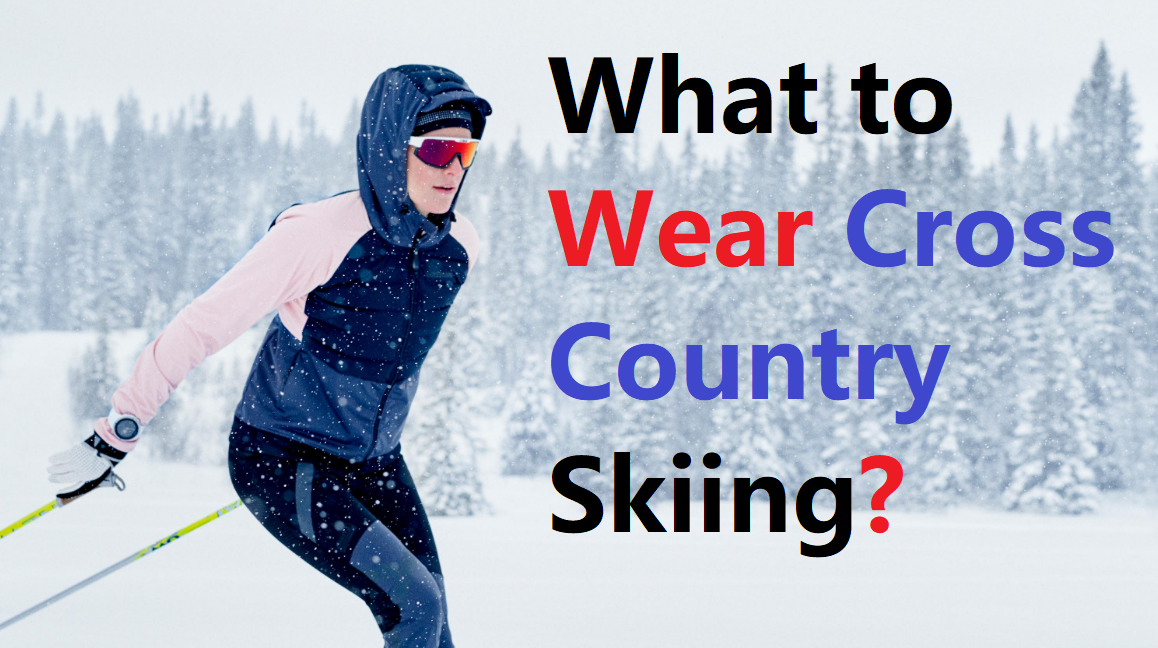What to wear cross country skiing? Among the most aerobic activities, cross-country skiing produces a lot of heat. So that you don’t overheat, your clothing needs to protect you from the elements while allowing sweat to move away from your body quickly. If it doesn’t, you risk getting chilled (and possibly hypothermic) once you stop. Cross-country skiers should wear multiple layers of lightweight clothing for warmth and versatility.
You can add or remove layers as needed, and it provides the most insulation during winter activities. Wear two lightweight layers rather than one bulky heavyweight layer for the best warmth. In order to retain warmth around your body, these layers trap what’s called “dead air space”.
Here’s a quick guide to what to wear while cross-country skiing, with more details below:
- Base layer: Your first layer of clothing should be made of synthetic or wool material that dries quickly and moves sweat away from your body so you don’t get cold.
- Middle layers: Next, you’ll want a layer for warmth, such as a fleece or lightweight puffy jacket.
- Outer layer: You’ll want a jacket that is water-resistant, windproof, and breathable.
Also, here are some general tips for how to manage your comfort while you’re out skiing:
- Be proactive. You shouldn’t wait until you’re too cold or too hot to change your clothes.
- Bring extra layers for extended outings. Having dry clothing in your daypack will come in handy if your clothes get wet from sweat or rain.
- Choose versatile clothing: Look for clothing with features that allow you to adjust or regulate your temperatures, such as zip-necks, vents, or front or side zippers.

Table of Contents
Base Layers for Cross-Country Skiing
The base layer is the first layer of clothing worn next to your skin. Underwear, tops, and bottoms should be comfortable and form-fitting, but not so tight that they restrict your movement. These could be base layers made of polyester or merino wool. You can wear non-cotton running or workout tights, yoga pants, or inexpensive thermal underwear. Here are some other tips for layering:
- Pick materials such as polyester or merino wool that wick moisture away from your skin toward the fabric’s outer surface. This will ensure that your sweat doesn’t soak your clothing and chill you. It’s advisable to avoid cotton because it absorbs your sweat and takes a long time to dry once wet.
- In winter, you may want a short-sleeved top, a lightweight or medium-weight long-sleeved top, or a zip-fronted top that lets you ventilate.
- Start out skiing a bit chillier than you expect (if that’s comfortable) because you’ll quickly heat up as you start moving.
Middle Layers for Cross-Country Skiing
On your upper body, wear one or two insulating layers. It will depend on the weather, how much sweat you produce, and whether you run hot or cold. If you’re skiing in warmer winter temperatures, you may need just one middle layer. Consider wearing two middle layers for warmth if you’re prone to getting cold or stop a lot.
Examples of middle layers:
- Lightweight fleece pullover
- Thin insulated vest
- Midweight base layer
- Lightweight puffy jacket
When you’re on a budget, look in your closet for items you already own. This might be a thin wool sweater, an inexpensive fleece top, or a training top you might wear running or cycling on cold days.
Outer Layers for Cross-Country Skiing
Some winter sports such as downhill skiing benefit from bulkier jackets, but cross-country skiing doesn’t because you’re constantly moving and could quickly overheat. When choosing outerwear, choose jackets or pants that are wind-resistant and breathable (that means the material allows moisture to pass through so you don’t get too hot or sweaty). It’s also important to make sure your outerwear can go over other layers.
Examples of outer layers:
- Soft-shell jacket: Soft-shell jackets are a good choice for most cross-country skiing days because they are waterproof and repel light snow or rain. But the material is also stretchy and permeable, moving with you while allowing perspiration to pass through so you don’t overheat.
- Hard-shell jacket: A softshell won’t protect you from heavy snowfall or downpour. For those situations, it’s helpful to have a waterproof/breathable hardshell jacket in your pack. Both windbreakers and breathable rain jackets are good choices for running, walking, or cycling in the winter.
Pants: Choose materials that are wind-resistant and breathable. Most people wear lightweight, non-cotton stretchy pants, such as yoga or running pants, which allow for a good range of motion. Depending on the temperature, you may wear these pants alone or over a base layer. Cross-country ski pants typically have a windproof material in the front and breathable, stretchy material in the back.
Hats and gloves for Cross-Country Skiing
It is possible for your head and hands to lose significant amounts of body heat if you do not cover them. For your head, a light cap with a visor works well on mild days.
- Keep your ears covered when it gets cooler with a headband or a wool or fleece hat. Protect your head and neck by wearing a balaclava when temperatures drop.
- For your hands, use a layering system: glove liners and windproof gloves or mittens. You can remove or add layers as the weather changes.
Socks and Gaiters for Cross-Country Skiing
As for your feet, you often wear a base layer (liner socks) and an insulating layer (thin wool or synthetic socks) – your ski boots act as the outer layer. You can certainly use thick socks to increase warmth, but keep in mind how much space you have in your boots. Another option is to wear over-the-ankle gaiters to prevent snow from sneaking into your boots.
Sun Protection for Cross-Country Skiing
Even on a cloudy day, you should protect yourself from direct sunlight and reflection off the snow. Wearing layers with complete skin coverage helps prevent sunburn and provides warmth and moisture wicking. Always wear sunglasses and apply sunscreen regularly.
FAQs
Pants for cross-country skiing should be lightweight and breathable just like jackets. But the fun thing about Nordic skiing is that you actually don’t have to wear pants.
Cross-country ski tights and leggings that are worn every day don’t protect against the wind and aren’t moisture-wicking. If it’s a mild day, or if they’re worn under windproof pants, they might be OK. It is too warm and bulky for Nordic skiing to wear downhill skiing jackets and pants.
Not to be confused with snowboarders who get the bottom of their pants stuck between the
back of their boot and the inside of their hips.
The toughest outdoor sport in the world, it requires a combination of strength, speed, and endurance. The lateral movements of skate skiing are unnatural and exhausting, whereas the technique of proper classic skiing leaves most novices feeling as though they are simply shuffled around.

